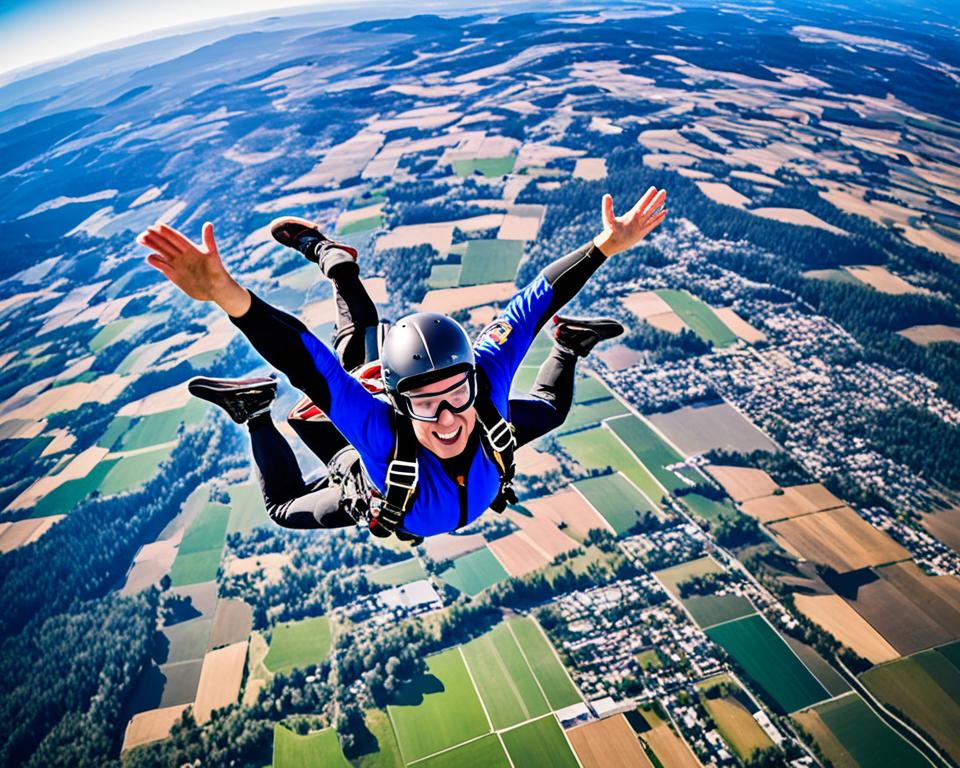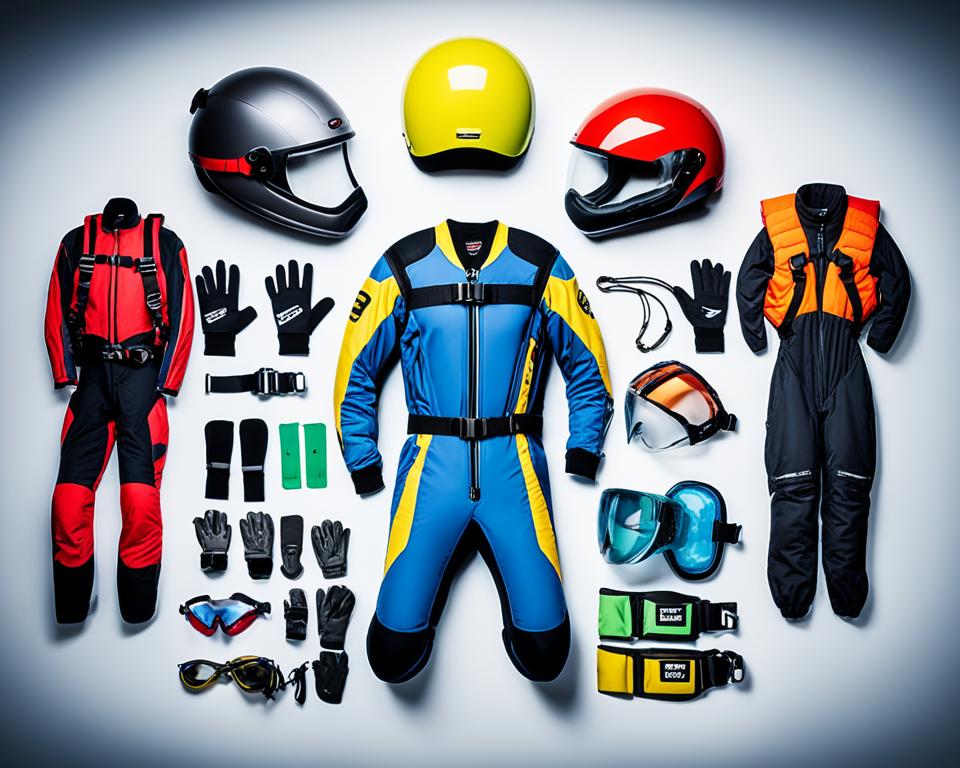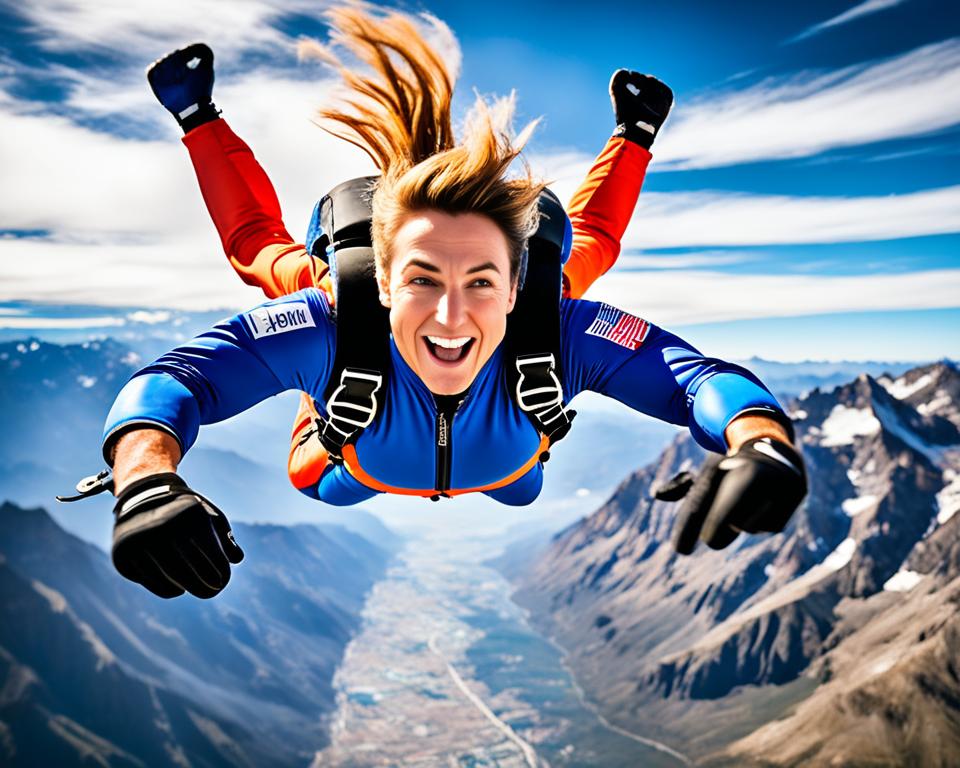Extreme skydiving is an adrenaline-fueled sport that takes the thrill of traditional skydiving to new heights. This article will guide you through the world of extreme skydiving, exploring the various disciplines, the breathtaking experience of freefall, and the essential gear and equipment required. We’ll also delve into the safety considerations, training and certifications, as well as the top destinations for extreme skydiving adventures around the globe. Whether you’re a seasoned skydiver or a thrill-seeker looking to push your limits, this article will provide you with the information and inspiration to embark on an unforgettable extreme skydiving journey.
Read interesting things at : vsocan
Key Takeaways
- Extreme skydiving offers an unparalleled adrenaline rush, taking traditional skydiving to new heights.
- Explore a variety of extreme skydiving disciplines, including BASE jumping, wingsuit flying, and high-altitude jumps.
- Discover the thrilling freefall experience and learn about the essential gear and equipment required.
- Understand the safety considerations and training needed to participate in extreme skydiving.
- Explore the top destinations around the world for unforgettable extreme skydiving adventures.
What is Extreme Skydiving?
Extreme skydiving is a specialized discipline within the broader sport of skydiving, where participants push the boundaries of traditional skydiving by engaging in more advanced and thrilling maneuvers. Unlike traditional skydiving, which typically involves jumping from a plane at around 14,000 feet, extreme skydiving often involves jumping from much higher altitudes, using specialized equipment like wingsuits, and performing acrobatic maneuvers during the freefall.
Defining the Adrenaline-Fueled Sport
At its core, extreme skydiving is an adrenaline-fueled sport that takes the already exhilarating experience of traditional skydiving to new heights. Participants in this discipline seek an even more intense and captivating adventure, driven by the desire to conquer their fears and push the limits of what is possible in the sky.
Differentiating Extreme Skydiving from Traditional Skydiving
The key distinguishing factors between extreme skydiving and traditional skydiving include the increased altitude of the jumps, the use of specialized equipment like wingsuits, and the incorporation of more advanced aerial maneuvers during the freefall. These elements combine to create an unparalleled sense of speed, weightlessness, and control that is the hallmark of the extreme skydiving experience.
The Thrill of Freefall
The freefall portion of an extreme skydiving jump is the most exhilarating and thrilling part of the experience. As jumpers plummet towards the earth at terminal velocity, they can reach speeds of up to 200 mph, creating an intense sensory overload that is unparalleled in any other sport. This heart-pounding freefall is what drives many extreme skydivers, as they seek to push their limits and conquer their fears.
Experiencing the Ultimate Adrenaline Rush
The rush of adrenaline coursing through the veins of an extreme skydiver during freefall is truly unparalleled. As they plummet through the air, the combination of speed, altitude, and the sheer thrill of the experience creates a sensory explosion that is both exhilarating and deeply captivating. This intense adrenaline rush is what fuels the passion of many extreme skydivers, driving them to seek ever-greater challenges and push the boundaries of the sport.
Overcoming Fear and Embracing the Moment
Conquering the inherent fear of freefall is a critical aspect of extreme skydiving. Jumpers must learn to embrace the moment, focusing their attention on the present and the sensations of the freefall rather than dwelling on the potential risks. Through comprehensive training and a steadfast commitment to safety, extreme skydivers are able to harness their fear and transform it into a profound sense of exhilaration and accomplishment as they soar through the air, parachuting back to earth.
Extreme Skydiving Disciplines
The world of extreme skydiving encompasses a diverse array of specialized disciplines, each offering its own unique set of challenges and thrills for the most daring and adventurous skydivers. From the adrenaline-fueled base jumping to the gravity-defying wing suits, these extreme skydiving disciplines push the boundaries of what is possible in the sky.
Base jumping, for instance, involves leaping from fixed objects like buildings, bridges, or cliffs, using a parachute to safely land. This discipline is renowned for its high-risk, high-reward nature, attracting the most experienced and courageous skydivers.
Wing suit flying, on the other hand, allows skydivers to glide through the air, defying gravity by wearing a specialized suit with fabric panels between the arms and legs. This thrilling discipline requires advanced training and skill, as wing suit flyers navigate the air currents and perform breathtaking maneuvers during their free fall.
High-altitude skydiving is another extreme discipline, where skydivers leap from altitudes exceeding 20,000 feet, pushing the limits of what is typically considered safe for traditional skydiving. These high-altitude jumps necessitate specialized equipment, extensive training, and the ability to cope with the reduced oxygen levels at such extreme elevations.
| Extreme Skydiving Discipline | Description | Key Challenges |
|---|---|---|
| Base Jumping | Leaping from fixed objects like buildings, bridges, or cliffs, using a parachute to safely land. | High-risk, technical maneuvers, and landing challenges. |
| Wing Suit Flying | Gliding through the air by wearing a specialized suit with fabric panels between the arms and legs. | Mastering air navigation, complex maneuvers, and precise control during free fall. |
| High-Altitude Skydiving | Jumping from altitudes exceeding 20,000 feet, requiring specialized equipment and training. | Coping with reduced oxygen levels, managing descent, and executing a safe landing. |
These are just a few examples of the diverse and thrilling extreme skydiving disciplines that captivate both participants and spectators alike. Each of these specialties offers a unique challenge and an opportunity for skydivers to push the boundaries of their skills and experience the ultimate adrenaline rush.
BASE Jumping: The Ultimate Extreme
In the realm of extreme skydiving, BASE jumping stands out as the ultimate test of skill, nerve, and adrenaline. This discipline involves leaping from fixed objects such as buildings, bridges, or cliffs, using a parachute to safely land. BASE jumping is known for its high-risk, high-reward nature, attracting the most daring and experienced skydivers who seek an even greater thrill than traditional skydiving.
Understanding the Risks and Rewards
BASE jumping is widely regarded as one of the most dangerous sports in the world, with a higher risk of injury or fatality compared to other extreme skydiving disciplines. The close proximity to the ground, the unpredictable wind conditions, and the limited opportunities for error make BASE jumping a true test of risk management and decision-making. However, for those willing to accept the challenge, the rewards can be immense, including the unparalleled adrenaline rush and the sense of pure freedom that comes with leaping from great heights.
Preparing for a BASE Jump
Becoming a BASE jumper requires extensive training, experience, and specialized equipment. Aspiring BASE jumpers must first master the skills of traditional skydiving, including freefall control, parachute deployment, and landing techniques. They must then undergo specialized BASE jumping training, which focuses on navigating the unique challenges of jumping from fixed objects and managing the increased risks. Rigorous safety protocols, including the use of specialized gear and the careful selection of jump sites, are essential in the pursuit of this extreme sport.
| Discipline | Description | Risks | Rewards |
|---|---|---|---|
| Base Jumping | Leaping from fixed objects like buildings, bridges, or cliffs using a parachute to land | Higher risk of injury or fatality due to the close proximity to the ground and unpredictable wind conditions | Unparalleled adrenaline rush and a sense of pure freedom |
Wingsuit Flying: Defying Gravity
Wingsuit flying is another captivating discipline within the realm of extreme skydiving, enthralling both participants and spectators alike. By donning a specialized suit equipped with fabric panels between the arms and legs, wingsuit flyers can manipulate the air, gliding effortlessly through the skies and defying the very laws of gravity.
The Technological Advancements in Wingsuits
The evolution of wingsuit design and materials has been a driving force behind the rapid progression of this extreme sport. Innovative technological advancements have resulted in wingsuits that offer improved stability, increased lift, and enhanced maneuverability, allowing wingsuit flyers to push the boundaries of what was once thought possible. From aerodynamic improvements to lightweight, yet durable fabrics, the constant refinement of wingsuit technology has elevated the extreme skydiving experience to new heights.
Training for Wingsuit Flights
Mastering the art of wingsuit flying requires extensive training and dedication. Aspiring wingsuit flyers must first hone their skydiving skills, gaining proficiency in freefall control and parachute deployment. They then progress to specialized wingsuit training, where they learn to navigate the complexities of body position, airflow, and flight patterns, all while maintaining the utmost focus on safety and risk management.
The adrenaline rush of wing suit flights is undeniable, as extreme skydivers glide effortlessly through the air, defying the forces of gravity. With each passing year, the sport continues to evolve, captivating both seasoned skydivers and thrill-seekers alike with its unparalleled feats of aerial mastery.
extreme skydiving
Extreme skydiving is a thrilling and adrenaline-fueled sport that takes the already exhilarating experience of traditional skydiving to new heights. By incorporating specialized disciplines like BASE jumping, wingsuit flying, and high-altitude skydiving, extreme skydivers push the boundaries of what is possible in the sky, seeking an even more intense and captivating experience.
These daring individuals embrace the free fall during their jumps, reaching speeds of up to 200 mph as they plummet towards the earth. The parachuting aspect of extreme skydiving adds an additional layer of excitement, as skydivers must skillfully deploy their specialized skydiving gear to safely land on the ground.
The thrill of extreme skydiving is further amplified by the incorporation of skydive photography, allowing jumpers to capture and immortalize the breathtaking moments of their adrenaline-fueled adventures. From the rush of freefall to the graceful descent under canopy, every aspect of extreme skydiving is designed to push the limits of human experience and deliver an unforgettable journey.
| Discipline | Description | Gear Required |
|---|---|---|
| BASE Jumping | Leaping from fixed objects like buildings, bridges, or cliffs, using a parachute to safely land. | Specialized parachute system, protective clothing |
| Wingsuit Flying | Gliding through the air using a specialized suit with fabric panels between the arms and legs. | Wingsuit, parachute system, additional safety equipment |
| High-Altitude Skydiving | Jumping from altitudes exceeding 20,000 feet, requiring specialized equipment and advanced training. | Oxygen system, pressure suit, parachute system |

High-Altitude Skydiving Adventures
Venturing into the realm of extreme skydiving, one discipline that captivates both seasoned skydivers and thrill-seekers alike is high-altitude skydiving. This specialized segment of the sport involves leaping from altitudes exceeding 20,000 feet, pushing the boundaries of what is typically considered safe for traditional parachuting.
Pushing the Boundaries of Altitude
High-altitude skydiving presents a unique set of challenges that require extensive training, specialized equipment, and the ability to cope with the reduced oxygen levels at such extreme elevations. Jumpers must be equipped with supplemental oxygen systems and possess the physical and mental fortitude to execute complex maneuvers during their freefall, all while experiencing the intense adrenaline rush that comes with plunging towards the earth at terminal velocity.
These high altitude jumps offer a thrilling and unparalleled experience, as skydivers soar through the sky, captivated by the breathtaking vistas and the overwhelming sense of freedom that comes with pushing the limits of what is possible. For the most dedicated extreme skydiving enthusiasts, conquering the challenges of high-altitude jumping is the ultimate testament to their skill and courage.
Skydiving Photography and Videography
Capturing the thrilling moments of extreme skydiving through skydive photography and videography has become an integral part of the sport, allowing participants to immortalize their adrenaline rush-fueled adventures and share them with the world. Whether it’s the breathtaking freefall, the graceful canopy ride, or the sheer exhilaration on the faces of jumpers, these visuals have the power to transport viewers and inspire the next generation of skydiving gear-clad adventurers.
Capturing the Breathtaking Moments
Skilled skydive photography and videography professionals have honed their craft to capture the essence of extreme skydiving in all its glory. From using specialized camera equipment to mastering the techniques of in-air filming, these visionary artists are able to freeze time and immortalize the adrenaline-fueled moments that define the sport. Whether it’s a perfectly-timed shot of a wingsuit flyer soaring through the sky or a sweeping aerial view of a group of skydivers performing a complex formation, the resulting imagery and footage are truly breathtaking.
Equipment and Techniques for Skydiving Photography
Capturing the thrilling extreme skydiving experience requires specialized skydiving gear and techniques. Skydivers and photographers alike must invest in lightweight, durable, and reliable camera equipment that can withstand the rigors of freefall and the unpredictable conditions of the sky. From action cameras mounted on helmets to high-end DSLR setups, the choice of gear is crucial in ensuring the capture of stunning, high-quality visuals that do justice to the sport.
Beyond the equipment, mastering the art of in-air photography and videography is a skill that requires extensive training and practice. Skydivers-turned-photographers must learn to maneuver their bodies in sync with the jumpers, anticipate the flow of the action, and time their shots with impeccable precision to create the most captivating and visually engaging content.
Skydiving Gear and Equipment
Extreme skydiving requires specialized gear and equipment to ensure the safety and performance of the jumpers. From the parachute system to the protective clothing and accessories, each piece of equipment plays a crucial role in the success and well-being of the skydivers. Investing in high-quality skydiving gear is essential for those seeking to engage in the thrilling world of extreme skydiving.
Essential Gear for Extreme Skydiving
The core of an extreme skydiver’s equipment is the parachute system, which includes the main canopy, reserve canopy, and deployment devices. These components must be rigorously tested and maintained to ensure reliable and safe parachuting during the jump. In addition, skydivers require protective gear such as helmets, goggles, and specialized clothing to shield themselves from the elements and potential impacts.
Maintaining and Inspecting Your Gear
Proper maintenance and regular inspection of skydiving gear is crucial for ensuring the safety considerations of extreme skydiving. Skydivers must meticulously inspect their equipment before each jump, checking for any signs of wear, damage, or malfunctions. This attention to detail helps mitigate the risks inherent in the sport and allows skydivers to focus on the exhilarating experience of their jumps.
| Gear Type | Key Features | Maintenance Considerations |
|---|---|---|
| Parachute System |
|
|
| Protective Gear |
|
|

Skydiving Competitions and Events
The world of extreme skydiving is home to a thriving skydiving community of enthusiasts, who come together to compete in prestigious skydiving competitions and events. These events provide a platform for the most skilled and daring skydivers to showcase their abilities, pushing the boundaries of what is possible in the sport.
Popular Skydiving Competitions Worldwide
From adrenaline-fueled extreme skydiving competitions to choreographed team events, the global skydiving calendar is filled with numerous high-profile competitions that attract the best skydivers from around the world. Some of the most renowned and prestigious skydiving events include the World Parachuting Championships, the Red Bull Skydive World Championships, and the Parachutist World Cup.
| Competition | Location | Event Highlights |
|---|---|---|
| World Parachuting Championships | Various Locations | Individual and team events, including skydiving competitions in disciplines such as Formation Skydiving, Accuracy Landing, and Freestyle. |
| Red Bull Skydive World Championships | Various Locations | Showcases the most daring and skilled extreme skydiving maneuvers, including adrenaline rush-inducing events like Skydive Acrobatic and Wingsuit Flying. |
| Parachutist World Cup | Various Locations | Combines traditional and skydiving competitions, featuring disciplines like Canopy Formation, Style, and Artistic Events that highlight the technical prowess and creativity of the skydiving community. |
These high-profile events not only provide a platform for the world’s best skydivers to compete, but also serve as a hub for the skydiving community to come together, share knowledge, and inspire the next generation of extreme skydiving enthusiasts.
Safety Considerations in Extreme Skydiving
Safety is of paramount importance in the world of extreme skydiving, as the sport inherently carries a higher level of risk compared to traditional skydiving. Extreme skydivers must be acutely aware of the potential dangers and be proactive in mitigating those risks through comprehensive training, rigorous safety protocols, and the use of high-quality equipment.
Mitigating Risks and Prioritizing Safety
Extreme skydiving requires a deep understanding of the sport’s inherent risks and a commitment to prioritizing safety at all times. Skydivers must undergo extensive training, honing their skills and emergency procedures, to ensure they are prepared for any contingency that may arise during their jumps. This includes practicing deployment procedures, managing equipment malfunctions, and executing safe landings, even in challenging conditions.
Additionally, extreme skydivers must be vigilant in their pre-jump checks, thoroughly inspecting their gear and equipment to identify and address any potential issues before takeoff. Maintaining and regularly servicing their parachutes, harnesses, and other critical components is essential to minimizing the risk of equipment failure during the jump.
Choosing Reputable Skydiving Operators
When pursuing extreme skydiving adventures, it is crucial to select reputable and experienced skydiving operators who prioritize safety and adhere to the highest industry standards. These operators should have a proven track record of safe operations, well-trained instructors, and a commitment to continuously improving their safety protocols.
Researching the safety ratings and certifications of potential skydiving operators is a vital step in ensuring a safe and enjoyable extreme skydiving experience. Skydivers should also familiarize themselves with the operator’s emergency response procedures and be confident in the operator’s ability to handle any unforeseen situations that may arise during the jump.
Training and Certifications for Extreme Skydiving
Comprehensive training and certifications are essential for anyone interested in pursuing the thrilling world of extreme skydiving. The progression from beginner to advanced levels in this sport requires a dedicated commitment to skill development, safety protocols, and the mastery of specialized techniques.
Progressing from Beginner to Advanced Levels
Aspiring extreme skydivers must first master the fundamentals of traditional skydiving, completing a series of training jumps and earning their basic skydiving certification. This lays the groundwork for the more advanced skills required for extreme disciplines, such as BASE jumping, wingsuit flying, and high-altitude jumps.
As skydivers progress, they will need to acquire specialized certifications and endorsements that demonstrate their proficiency in specific extreme skydiving techniques. This involves extensive theoretical and practical training, supervised jumps, and the demonstration of advanced skills before being granted the necessary certifications by recognized skydiving organizations.
The development of extreme skydiving skills is an ongoing process that requires regular practice, continuing education, and the guidance of experienced mentors. Skydivers must continuously hone their abilities, stay up-to-date with the latest equipment and techniques, and strive to push the boundaries of their own personal limits.
By investing in comprehensive training and earning the necessary certifications, extreme skydivers can ensure they have the knowledge, skills, and confidence to navigate the challenges and inherent risks of this thrilling sport, ultimately enhancing their overall safety and enjoyment of the experience.
Extreme Skydiving Destinations around the World
The world is a vast playground for extreme skydiving enthusiasts, with a multitude of destinations offering unique and thrilling experiences. From iconic landmarks to stunning natural landscapes, these locations cater to the most daring and adventurous skydivers, providing them with the opportunity to push their limits and create unforgettable memories.
Exploring the Best Skydiving Locations
Whether you’re seeking the adrenaline rush of jumping from towering cliffs or the breathtaking views of jumping over pristine landscapes, the global skydiving community has curated a diverse array of extreme skydiving destinations to satisfy your craving for adventure. From the rugged beauty of New Zealand’s Southern Alps to the captivating cityscapes of Dubai, these skydiving destinations offer a thrilling blend of natural and manmade wonders, catering to the most extreme skydiving enthusiasts.
| Destination | Highlights | Best for |
|---|---|---|
| Queenstown, New Zealand | Stunning alpine landscapes, opportunities for BASE jumping and high-altitude skydiving | Extreme skydiving, adrenaline rush, skydiving community |
| Dubai, United Arab Emirates | Iconic skyscrapers, desert terrain, and the opportunity to skydive over the city | Extreme skydiving, skydiving destinations, adrenaline rush |
| Interlaken, Switzerland | Stunning Alpine scenery, options for BASE jumping and wingsuit flying | Extreme skydiving, skydiving destinations, skydiving community |
| Moab, Utah, USA | Dramatic red rock formations, opportunities for high-altitude skydiving and BASE jumping | Extreme skydiving, skydiving destinations, adrenaline rush |
These are just a few of the many extreme skydiving destinations around the world, each offering its own unique challenges and thrills for the most adventurous skydivers. As the skydiving community continues to push the boundaries of the sport, new and exciting locations are sure to emerge, providing extreme skydiving enthusiasts with endless opportunities to quench their thirst for adrenaline rush.
The Skydiving Community and Culture
The world of extreme skydiving is not just about the thrill of freefall and the pursuit of adrenaline-fueled adventures. It is also a vibrant and close-knit community that celebrates camaraderie, skill, and a shared love for the sport. Extreme skydivers come together from all corners of the globe, united by their passion for pushing the boundaries of human flight and creating unforgettable experiences.
A Thriving Community of Enthusiasts
Extreme skydiving is more than just a hobby; it is a lifestyle that attracts a diverse array of individuals, each with their own unique story and perspective. From seasoned veterans to aspiring newcomers, the skydiving community welcomes all those who are willing to embrace the challenge and immerse themselves in the excitement of the sport. This community fosters a sense of belonging, where skydivers share knowledge, offer support, and push one another to reach new heights.
Fostering a Culture of Skill and Respect
Within the skydiving community, there is a deep respect for the mastery of the sport. Extreme skydivers are often highly skilled individuals who have dedicated countless hours to perfecting their techniques, honing their reflexes, and staying up-to-date with the latest advancements in skydiving gear and equipment. This culture of skill and respect creates an environment where skydivers can learn from one another, push the boundaries of what is possible, and celebrate each other’s accomplishments.
The Thrill of Shared Experiences
The allure of extreme skydiving lies not only in the individual rush of freefall, but also in the shared experiences that bind the community together. Whether it’s the exhilaration of a successful BASE jump, the awe-inspiring vistas captured during a wingsuit flight, or the camaraderie of a skydiving competition, these moments create lasting memories and strengthen the bonds within the skydiving community. It is this sense of shared adventure and the collective pursuit of the impossible that makes the skydiving lifestyle so captivating and unforgettable.


